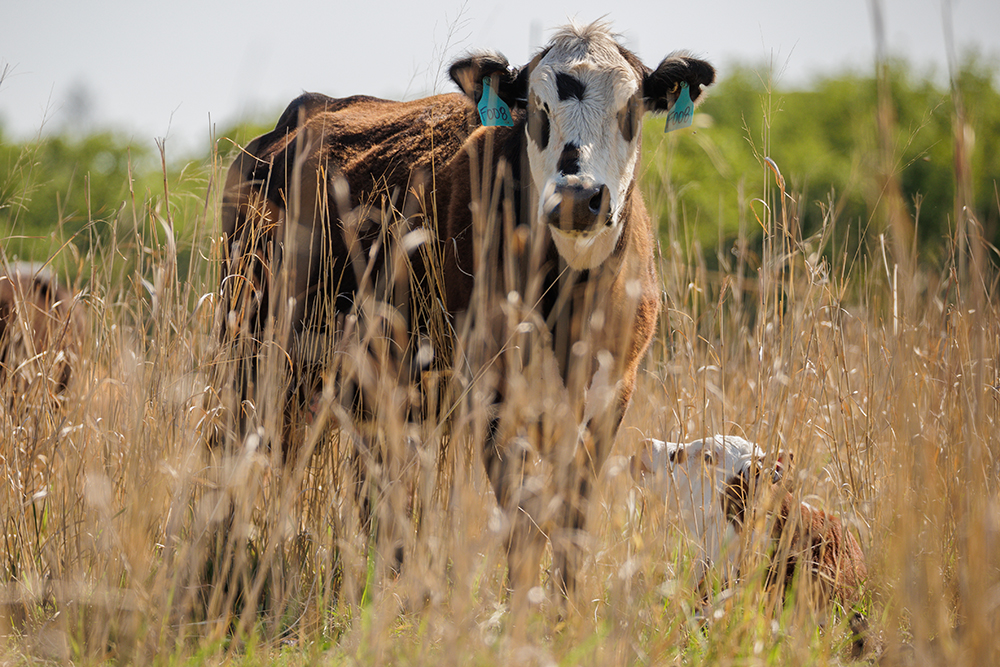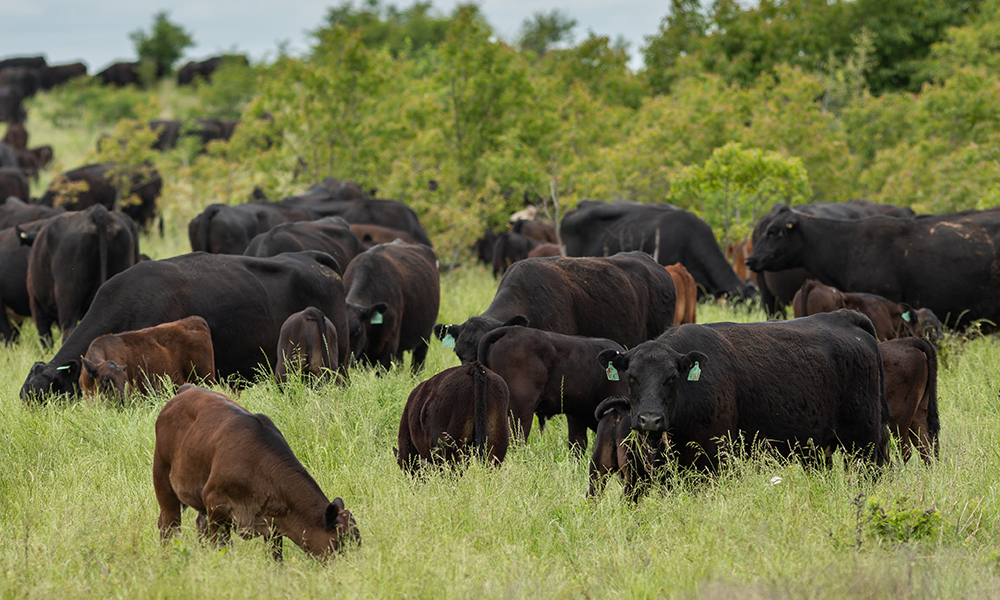Match forage flow with livestock nutritional needs to increase ranch profitability
Coordinating your calving or lambing season with peak forage availability can cut costs for feed, supplementation and labor, a Noble regenerative ranching advisor says.
Each year, the average rancher spends 40-60% of his or her cow costs on supplemental feeding, says Robert Wells, a Noble Research Institute senior regenerative ranching advisor.
If you’re having to supplement your livestock’s nutrition four to five months out of the year, imagine what reducing those costs by even a small margin could do for the bottom line. Wells recommends taking a new look at the timing of breeding and calving/lambing/kidding seasons in order to optimize nutrition from grazing.
“Our goal as good, astute managers should be to time our highest nutritional requirements of our livestock with when we’ve got the best quality and quantity of forage in front of that animal,” he says. “If we do that, we should be able to back off that supplementation. That can be a huge cost savings.”
Wells offers a handful of questions ranchers can ask themselves and considerations they can make to evaluate how well their production plan matches their forage flow.

Evaluate your environment
Charting forage flow on paper may offer a clear visual of key factors for consideration. Many ranchers carry this information in their heads, but committing it to paper can create a powerful visual tool that can benefit even the most seasoned rancher.
Start by inventorying what grasses or forages are available and whether they are predominantly warm- or cool-season plants. Then, mark on a timeline when each species or category is at peak quality in terms of protein and energy value.
Most local extension offices can offer average crude protein (CP) and total digestible nutrient (TDN) content measurements for native or introduced forages in your region, along with the typical variations in those measurements throughout the season. Or, have your forage tested to get a more accurate reading on your particular situation.
Then, mark when that peak in forage quality coincides with peak quantity.
“When I say quantity, I mean, when do you get to the point where a cow can wrap her tongue around a bunch of grass, get a mouthful, stand there and chew on it, and just move her head to get another bite that she doesn’t have to walk to,” Wells says. “In the spring, at first green-up, we know that grass is really high quality. But if a cow is having to take a bite and then walk 10 feet to get another bite, that’s just a nibble. She’s expending more energy than she’s getting.”
Next, mark on the timeline when your forage typically tapers off. When does grass start to harden or go to seed, if left to mature?
Charting warm-season grasses will likely look like a typical bell curve, with peak production in May, June, July or August, depending on your geographic location, while cool-season grasses may hit their peak in April, May or early June, location depending, with another smaller bump in production in the fall before frost.
Once you have a flow chart of forage quality and quantity, make note of your typical weather patterns with expected peak rainfall and seasons of extreme heat or challenging cold.

Know your animals’ needs
Next, chart the peaks and valleys of your animals’ nutritional needs throughout the year, starting with your traditional calving/lambing/kidding season in mind. The animal’s highest nutritional requirements coincide with peak lactation needs. For cattle, that’s two to three months after calving; for sheep and goats, it’s four to six weeks post-partum. It also can be breeding season if you are trying to keep cows on an annual calving interval.
“At the beginning of your breeding season, you want that cow’s body thinking it’s never going to have another bad day in its life from a nutritional standpoint,” Wells says.
The second most important time frame for nutritional demand in a dam’s life will be when she enters her third trimester. Nearly two-thirds of fetal growth occurs in the final trimester of pregnancy.
Finally, make note of special considerations particular to your environment. Extreme cold (temperatures below 32), or when the cow is wet and cold (at 59 degrees or less), can increase the cow maintenance requirement by 20% during the time of cold stress. That’s an important factor if those extreme environmental factors coincide with times when she and the developing fetus are already under pressure.
Now, compare the highs and lows of the natural nutrition available from forage with the nutritional needs of your livestock. Do her greatest needs correspond with the peak forage production charts? Do you see opportunities to make these charts overlap better?

Calculate the costs
If you see big gaps between the animals’ nutritional needs and your forage flow at key junctures, it may be time to admit your nutritional supplementation program is, in fact, a substitution program.
Any periods when animals get the majority of their nutritional needs met from your feed truck may be the first places to look if you want to improve profitability.
“Sharpen the pencil and really look at the numbers that go with that substitution program,” Wells says. If you’re not familiar with calculating your animals’ nutritional needs or the nutritional availability you have, get with a nutritionist and have them help you run some of these numbers. Factor in the nutrition and the costs of all additional sources of forage and feed.
Then, consider the costs and the savings of shifting the two charts to more closely align. Would a closer alignment of peak forage production and calving or lambing timing allow you to reduce what you have to supply to meet the mother’s needs? What would it cost to plant a cool-season cover crop in order to fill in some nutritional gaps?
Don’t forget to calculate in the cost of your time, labor, and equipment in each of these scenarios, too, Wells says. What if you could shift these seasons so you only have to supplement her feed every other day, instead of every day? Consider the potential financial savings associated with cutting labor, fuel, wear and tear on equipment, etc., in half, or even simply reducing the amount you need to feed each day.
Don’t forget to calculate the opportunity cost of your home-grown hay, too, Wells says.
If you’re going to put up the same amount of hay every year, but you usually feed all 1,000 bales that you grow, think about what it might look like to align your calving season with your forage flow and be able to cut the number of bales you feed in the winter to 850. Then you have 150 bales to sell to your neighbor. Or, only put 850 bales up, save wear and tear on your equipment and time in the field, and use the cattle to graze those hayfields in order to extend your grazing season and lengthen rest periods on your traditional pastures.

Make your marketing considerations
Every single ranch will have different answers to these questions, Wells says. The point is not to push yourself to a prescriptive change in management or to assume every ranch needs to change their production plan.
Rather, he says, it’s about getting a clearer picture of why you are in the model you are, and what’s driving those decisions.
“We’ve got to look at the whole picture,” Wells says. “We can’t just be asking, ‘How am I going to wean the biggest calf?’”
Instead, he suggests a better question might be, “What’s it going to cost to get that cow through the winter, and is that worth marketing an older calf? Or, can you sell a little lighter calf, make less per calf, but spend even less to get him there?”
In some of the economic scenarios he’s played out using this line of questioning, he has seen as much as a $30-per-head cost savings per feeding season by shifting a calving window to align with forage flow more closely.
“We can’t take any one of these pieces of information and develop a management plan in isolation,” Wells concludes. Seeing the bigger picture “takes looking at not just the number of dollars that come into the system at marketing time, but tracking the total dollars that stay in my checking account after all the bills are paid at the end of the year.”



Comment